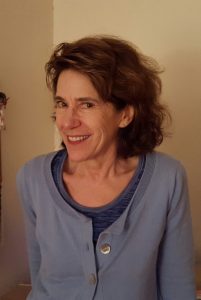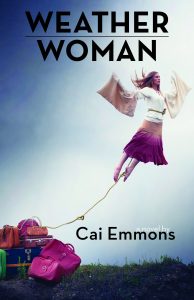How The Weather Influences My Writing
 The idea for a novel does not usually arrive—for me at least—in a sudden “aha” moment. It is a process that takes place over time. Some of my ideas have lived in me for years like spores I scarcely knew were present until they found the fertile soil in which to sprout. Weather Woman was such a project, seeded years before it sprang to life.
The idea for a novel does not usually arrive—for me at least—in a sudden “aha” moment. It is a process that takes place over time. Some of my ideas have lived in me for years like spores I scarcely knew were present until they found the fertile soil in which to sprout. Weather Woman was such a project, seeded years before it sprang to life.
The novel tells the story of a meteorologist who discovers she has the power to change the weather. The germ of the book harkens back to my early childhood in New England when I was riveted by weather, extreme weather in particular. I adored the two-foot blizzards that kept us home from school and the hurricanes we would watch from an attic window ooh’ing and ah’ing as the trees whipped and jerked like giant pompom dancers. Too young to think about what dangers the storms brought on, I was enthralled by the weather’s intensity and loved having “normal” life interrupted.
There were also many times when I wished the weather were different: when it was so cold on Halloween I had to wear a coat over my costume, or when a beach expedition had to be cancelled due to rain. At those times I fervently wish I could change the weather. And sometimes I felt I actually could change things a little. I would lie in the back yard, staring up at the clouds, and imagine I could move them (look at clouds for any more than a minute and they always move!).
My weather fascination continued (continues) into adulthood. I was heartbroken to awaken to rain on my wedding day in late May. And when I moved to Southern California a friend from back east came to visit me in February, hoping to sunbathe, maybe frolic in the waves, but it was fifty degrees and overcast. I felt like a failed hostess for not being able to make the weather more cooperative.
Cut to the twenty-first century. I was in France during the summer of 2003 when there was a massive European heat wave that killed more than 14,000 people in France alone. In 2012, when Hurricane Sandy hit and I saw the pictures of devastated New York City, where I had lived for over a decade, I was horrified, both wishing I was there and happy I was not.
Sometime in the year or so after Sandy, the idea for Weather Woman took root. What if someone could influence the weather and call off such storms? How would a person use such a power? What would it mean interpersonally? What would it mean for the world? I began to write, first conceiving of a male meteorologist who had this weather-changing power then, at someone’s excellent suggestion—why hadn’t I thought of this before?—changing the character to a woman.
For every novel I write I have a spiral notebook with blank pages. I use it to ask myself questions, to jot notes, to lay out areas that need to be researched.
What does a TV meteorologist really do? What is the rhythm of her days? What is it like for her to go on air? Who does she work with? Where does she live? Does she have a partner?
As soon as one question is answered, another pops up. My meteorologist has dropped out of an atmospheric sciences PhD program.
What was she studying? What is it like to do atmospheric research? I like to start writing sentences and scenes, but I try to restrain myself until I know a few things. Still, I often move into writing with many questions unanswered, much research ahead; sometimes it’s only in the writing itself that I understand what I need to learn.
A novel’s “idea” at the outset is very amorphous. It bears something in common with a cloud, drifting here and there, shape-shifting. The process is, in the early stages, directed more by the unconscious than by the conscious mind. I never know what a novel is really about at the deepest level until I’ve completed a first draft.
Even then it may shift in the rewriting. I see Weather Woman as being a story about female empowerment, set against a backdrop of extreme weather and climate change (both of which contribute their own “aboutness” to the story). I did not set out to write explicitly about these things, I was simply compelled by the story itself, a story that seemed to ask for probing beneath the surface to the subterranean currents.
One of the dictionary definitions of inspiration relates to breathing. “The act of drawing in, specifically of air into the lungs.” Writing a novel entails a similar kind of drawing in.
When I’m at work on a novel I sometimes feel I’ve sent out antennae to dowse for any and all artifacts that might be relevant to what I’m writing about.
With Weather Woman, sending out such antennae led me to getting in touch with glaciologist and climatologist Jason Box, who studies the ice and snow in Greenland. He suggested I accompany him on a trip to Greenland where he was going to be the resident scientist. I couldn’t imagine a more auspicious opportunity. The trip, taken in late June during the days of perennial sunlight, was breathtaking, eye-opening: kayaking among the icebergs, the ethereal blue light, the shock of seeing a calving glacier. The horror of global warming became visceral, and Jason and I became friends. All a result of sending out those antennae.
For inspiration to come, a writer must always have her antennae extended. She should always be watching, listening, absorbing—one never knows when those long-dormant spores will be ready to express themselves.
—
Cai Emmons is the author of the novels His Mother’s Son and The Stylist. Her newest novel Weather Woman, is about a meteorologist who discovers she has the power to change the weather. Cai’s story collection, Vanishing, winner of the 2018 Leapfrog Press Fiction Contest, will be published in the fall of 2019. Formerly a playwright and screenwriter, her short work has appeared in such publications as TriQuarterly, Narrative, and Arts and Culture, among others. She is a graduate of Yale University, New York University, and the University of Oregon where she now teaches in the Creative Writing Program.
Twitter: @caiemmons
Facebook: @caiemmons
Weather Woman Page: @WeatherWomanNovel #WeatherWomanNovel
Instagram: @caiemmons
Website www.caiemmons.com or www.caiemmonsauthor.com
About WEATHER WOMAN
 Thirty-year-old Bronwyn Artair, feeling out of place in her doctoral program in Atmospheric Sciences at MIT, drops out and takes a job as a TV meteorologist, much to the dismay of her mentor, Diane Fenwick. After a year of living alone in Southern New Hampshire, enduring the indignities of her job, and being dumped by her boyfriend, she discovers her deep connection to the natural world has given her an ability to affect natural forces.
Thirty-year-old Bronwyn Artair, feeling out of place in her doctoral program in Atmospheric Sciences at MIT, drops out and takes a job as a TV meteorologist, much to the dismay of her mentor, Diane Fenwick. After a year of living alone in Southern New Hampshire, enduring the indignities of her job, and being dumped by her boyfriend, she discovers her deep connection to the natural world has given her an ability to affect natural forces.
When she finally accepts she really possesses this startling capability, she must then negotiate a new relationship to the world. Who will she tell? Who will believe her? Most importantly, how will she put this new skill of hers to use?
As she seeks answers to these questions, she travels to Kansas to see the tornado maverick she worships; falls in love with Matt, the tabloid journalist who has come to investigate her; visits fires raging out of control in Los Angeles; and eventually voyages with Matt and Diane to the methane fields of Siberia. A woman experiencing power for the first time in her life, she must figure out what she can do for the world without hurting it further. The story poses questions about science and intuition, women and power, and what the earth needs from humans.
Buy the novel HERE
Category: On Writing






























